Alexander 2.7
Alexander the Great (*356; r. 336-323): the Macedonian king who defeated his Persian colleague Darius III Codomannus and conquered the Achaemenid Empire. During his campaigns, Alexander visited a.o. Egypt, Babylonia, Persis, Media, Bactria, the Punjab, and the valley of the Indus. In the second half of his reign, he had to find a way to rule his newly conquered countries. Therefore, he made Babylon his capital and introduced the oriental court ceremonial, which caused great tensions with his Macedonian and Greek officers.
The Levant
Phoenicia
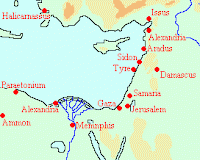
In November 333, the Macedonians had defeated the large army of the Persian king Darius III Codomannus, and Alexander was now faced with a difficult choice. He could pursue the defeated Darius to the east and march on Persepolis, the Persian capital. He had promised the Macedonians and Greeks at home to punish the Persians for Xerxes' expedition in 480 BCE; the looting of Persepolis could mean the end of the war.
The alternative was not to pursue Darius. There were many arguments for this policy, the most important being that the Persian fleet, commanded by Pharnabazus, was still in control of the Aegean sea and the Hellespont. Alexander's line of supplies was threatened, and the best thing he could do was to take the Phoenician towns (Aradus, Tripolis, Byblos, Berytus, Sidon, and Tyre), where the crews of Pharnabazus' ships came from. The conquest of the Levant was a strategic necessity.
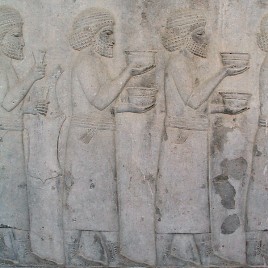
There were additional advantages. Alexander could continue to the south and conquer Egypt. On several occasions, the pharaohs of the ancient country along the Nile had sent wheat to Athens; since food crises were common in Antiquity, Alexander could count on the eternal gratitude of the Macedonians and Greeks if he could open a trade route between Egypt and the homeland.
Besides, we must not ignore the motive given in our sources: Alexander wanted to go to Egypt because Perseus and Heracles - ancestors of Alexander - had done so. To Alexander, who took his legendary ancestry very serious, this was a more valid reason than it is to us. A final reason for paying a visit to Egypt, was that the Greeks and Macedonians were fascinated by this country. Business could be combined with pleasure.
The Phoenician towns surrendered as soon as Alexander approached. (In Sidon, Abdalonymus was appointed as king.) These were very, very ancient cities, which had had urban life at least millennium and a half before the Greek towns originated.
Tyre
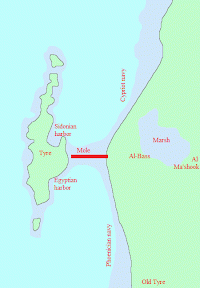
The only Phoenician city that refused to come to terms was Tyre (Sur in the language of its inhabitants, "rock"), and Alexander knew that the siege was going to last for months. The situation was more or less comparable to Halicarnassus: he was besieging a harbor town, the enemy had excellent ships and could come and go as they liked. The difference was that the fortifications of Halicarnassus had been protected by a ditch of only fifteen meters wide and that the walls of Tyre were protected by the sea: the old city was built on an island.
Another difference was that the capture of Tyre was strategically unnecessary. Tyre had offered surrender, but had refused Alexander the right to sacrifice in the temple of Melqart during the great festival in February, because only a native king could perform the necessary religious ceremonies. Alexander had felt insulted and had insisted, and this was the sole cause of the siege. No Persian king had ever made such an outrageous demand.
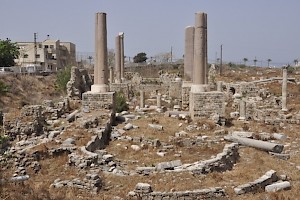
In January 332, the siege began. The consequences were clear at once: the Tyrians were forced to recall the ships that had been fighting in the Aegean sea. Since the other Phoenician towns had already recalled their ships after the towns had surrendered to the Macedonians, the Persian naval offensive in the Aegean sea came to an end.
To reach the Tyrian walls, the Macedonians built a mole. But the Tyrians still commanded the sea and made the construction extremely difficult. Alexander needed ships to protect the construction, and he was lucky, because Aradus, Tripolis, Byblos, Beirut and Sidon had just recalled their navies. In July, the town was attacked from three sides: the Phoenician fleet destroyed the Tyrian fleet in the "Egyptian port"; Macedonian ships attacked the walls with siege engines; and marines from Cyprus landed in the "Sidonian port" and forced their way into the city.
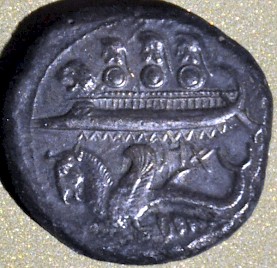
According to our sources, 6,000 Tyrians were killed during the fighting in the streets (many of which were so narrow that it was easy to step from roof to roof across the street). 4,000 Macedonians were wounded, perhaps 500 were killed. Alexander's indulged in his anger: he ordered 2,000 Tyrians to be crucified on the beach (text).
Gaza
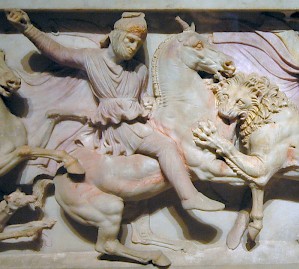
From now on, Macedonia ruled the waves, and it was easy to bring the siege engines to Gaza, the next town that refused to surrender. The strong walls crowned a steep hill and Alexander's engineers were afraid that they could never take the town. Nonetheless, they constructed a mound. The siege engines, however, were unable to destroy the fortifications. Not to be outdone, the engineers built mines and made the wall collapse. After a siege of four months, Gaza fell in October 332. The male population was killed to a man.
The Persian governor of Gaza, Batis, had done an excellent job: he presented his king with extra time to gather a new army. Alexander was furious, ordered the man to be tied to his chariot, and dragged him around the city. This behavior was inspired by Alexander's legendary ancestor Achilles, who, according to Homer, had dishonored the corpse of the Trojan warrior Hector in a similar way (text).
There is one source, the Jewish historian Flavius Josephus, in which we read about a visit Alexander paid to Jerusalem. There are many elements in Josephus' narrative that suggest that the story belongs to Jewish legend, not history. On closer inspection, however, the story - stripped of some implausible details - is consistent and may well be true. It is discussed over here. It is certainly possible that the Jews supported Alexander during his campaign against Gaza, and helped him in Egypt, a country which the Jews knew well (the Persians had used them to garrison the southern border at Elephantine). Alexander certainly used Jewish mercenaries to guard the city he was to build in Egypt, Alexandria.